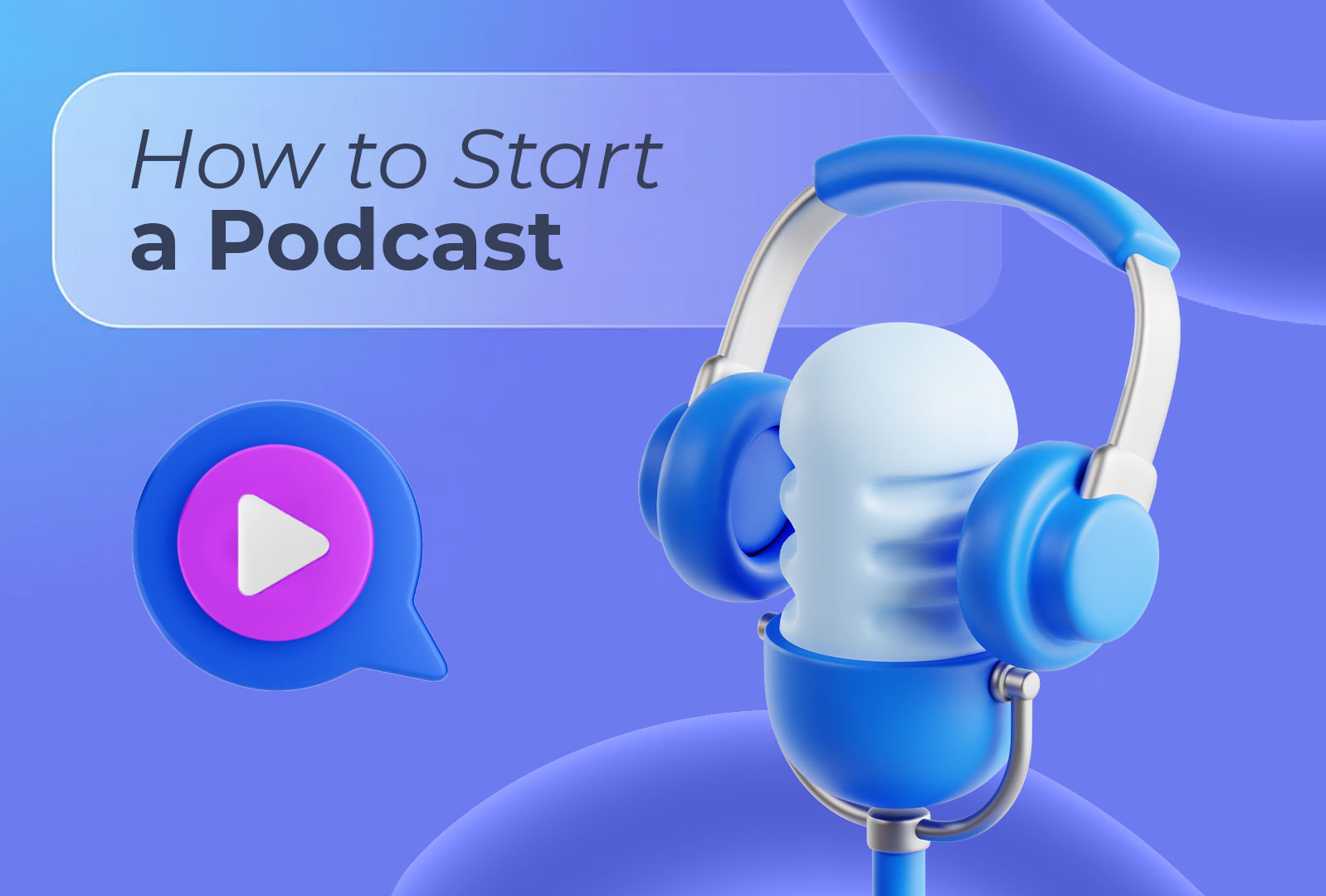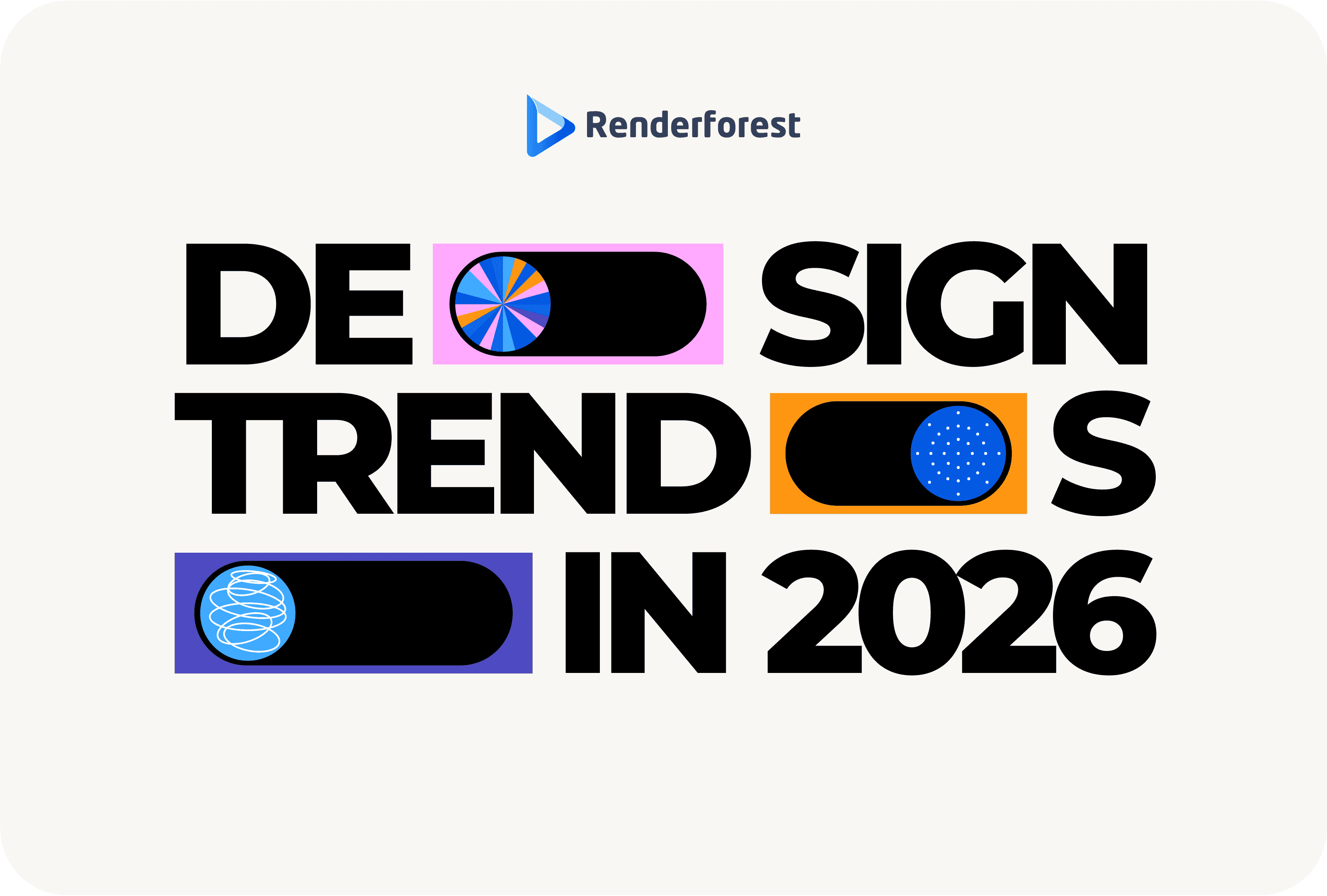
Design
Podcasts are more popular than ever, offering a great way to share jokes, ideas, stories, and expertise. With that in mind, it’s probably tempting to start your own. If you’re not sure where to begin, this guide will show you every step of how to start a podcast. We’ll cover everything you need to know, from planning your content to choosing the right equipment and using helpful tools. Let’s set you up for your podcasting journey.
Before we dive into the steps of starting your own podcast, let’s understand what a podcast really is and how it all began.
A podcast is a digital audio or video program available for streaming or download on the internet. Unlike traditional radio or TV shows, podcasts are typically produced in series, with each episode focusing on a specific topic or theme. This flexibility allows creators to explore a wide range of subjects, from storytelling and news to education and entertainment.
The term “podcast” was coined in 2004, combining “iPod” (Apple’s portable media player) and “broadcast.” The concept, however, dates back to the early 2000s when the advent of broadband internet and portable media devices made it easier to distribute and consume digital audio content.
The first podcasts were simple audio files that users could download and listen to on their computers or MP3 players. As the technology evolved, so did the quality and variety of podcasts. Apple’s inclusion of podcasts in its iTunes store in 2005 significantly boosted their popularity, making it easier for users to find and subscribe to their favorite shows.
Over the years, podcasting has grown exponentially. Today, there are millions of podcasts available on a wide range of platforms, including Apple Podcasts, Spotify, and Google Podcasts. The medium has also expanded to include video podcasts, offering a visual element that appeals to many viewers.
Podcasting allows creators to connect with their audience on a deeper level, share their expertise, and even generate income through sponsorships and advertising. No wonder everyone’s doing it.
With all this information at hand, you may still be wondering how you can actually benefit from starting a podcast. Let’s talk about why podcasting is a great opportunity.
Podcasts are an effective way to connect with people who share your interests. To understand how to start a podcast with no audience, focus on creating engaging and valuable content that resonates with potential listeners. By targeting topics that matter to your desired audience and promoting your podcast through various channels, you can attract podcast listeners from all over the world. As your audience grows, so will your influence. This can open up new avenues for networking, collaboration, and even expanding your reach across different platforms.
Are you passionate about a particular topic? Podcasts serve as a platform for you to share your knowledge with others. Whether you’re discussing industry trends or simply telling stories, podcasts allow you to showcase your skills and experiences while establishing yourself as an expert in your field. Your perspective could educate, entertain, and inspire people listening.
Podcasting can become a profitable initiative, too. As your audience grows, you may attract sponsors and advertisers who want to reach your listeners. Many podcasters monetize their shows through sponsorships, advertisements, and affiliate marketing. You can also offer premium content or merchandise to your dedicated fans. With dedication and quality content, your podcast can become a source of income.
Starting a podcast can also be a rewarding personal experience. It encourages you to improve your communication skills, learn new technologies, and stay updated on trends in your field. It’s a creative outlet that allows you to express yourself and connect with others on a deeper level.
So, whether you’re looking to build an audience, share your expertise, or explore new revenue streams, podcasting offers a multitude of benefits.
Thinking about how to start a podcast on YouTube or any other platform? Planning a podcast involves several key steps to make sure your show is engaging and professional—and that it resonates with your target audience.
Choosing a compelling and relevant topic is the first step in planning your podcast. Your topic should align with your interests and expertise while also appealing to a broad audience. Here are some points to consider:
Pick a topic you’re passionate about and knowledgeable in. This will keep you motivated and guarantee you provide valuable content to your listeners. For example, if you love cooking and have a wealth of tips, a food podcast would be ideal.
Research popular podcast categories to understand what potential listeners are looking for. Many studies claim that the most popular podcast genres appear to be comedy, news, and true crime. If you choose true crime, for instance, you can expect to have a large, dedicated audience of die-hard crime show fans.
Make sure your topic has enough depth to sustain multiple episodes. Avoid topics that might be too narrow and could run out of content quickly. Consider creating a list of potential episode ideas to see how versatile your topic can be.
Look at what other podcasters are doing in your chosen topic area. Identify what they do well and where there might be gaps you can fill. This can help you differentiate your podcast and offer something unique to your listeners.
Examples and video references
The format of your podcast plays a major role in how well it engages your audience. Here are some popular formats to consider, along with factors to help you decide which one suits your podcast best:
Featuring guests can bring diverse perspectives and expertise to your show. Examples like “The Joe Rogan Experience” and “How I Built This” highlight the appeal of gaining insights from various personalities. This format keeps content fresh and dynamic.
Share your thoughts and expertise directly with your audience. This format, as you can see in “The Tim Ferriss Show,” allows for deep dives into topics without the need for guest coordination. It’s perfect for showcasing your personal insights and knowledge.
Hosting a group of experts to discuss a topic can provide in-depth exploration of complex subjects. “The Moth” podcast often uses this format, offering varied viewpoints and lively debates. This setup can make your podcast more interactive and engaging.
Weaving a story through each episode or series can be highly engaging. Popular examples include “Serial” and “This American Life.” Storytelling podcasts can build a loyal following through compelling narratives and suspense.
Combining elements of different formats can keep your podcast dynamic. For example, alternating between interviews and solo segments allows you to explore topics in various ways, keeping your audience hooked.
Understanding your target audience is crucial for creating content that resonates. Here’s how to define your ideal listener:

Account for the age, gender, location, and occupation of your potential listeners. For example, if your podcast is about parenting tips, your audience will consist of parents aged 25 to 40.
See what your audience is interested in and what type of content they prefer. Are they looking for educational content, entertainment, or a mix of both? Understanding these preferences can help tailor your content to meet their needs.
Understand when and how your audience listens to podcasts. Are they tuning in during their commute, while working out, or in the evenings? This can help you decide on episode length and release times.
Figure out where your audience hangs out online. Are they active on social media, forums, or other platforms? This information can guide your promotion and engagement strategies.
Connect with your potential audience through surveys, polls, and social media interactions. Ask them what they’d like to hear in your podcast. This direct feedback can be valuable in shaping your content.
Look at similar podcasts and their audiences. What are they doing well? What gaps can you fill? Tools like Podchaser can help you gather insights about your competitors and their listeners.
As a podcast host, choosing the right name for your podcast is crucial as it’s often the first thing potential listeners will notice. Here are some tips to create a memorable and descriptive podcast title:
Make sure the name reflects the content and tone of your podcast. It should give listeners an idea of what to expect.
Keep it short and easy to remember. Avoid complex words and phrases.
Make sure the name isn’t already in use. You want a name that stands out and is easily searchable.
Consider including keywords that potential listeners might use to search for content related to your podcast.
Say the name out loud, ask friends and family for their opinions, and make sure it sounds good and is easy to pronounce.
Example
Creating a strong brand for your podcast involves establishing a cohesive visual identity and tone.
Content pillars are the core themes or topics that will guide your podcast episodes. Here’s how to outline them:
Planning the structure of your episodes helps maintain clarity and listener interest.
To produce high-quality podcasts, you need the right equipment and processes.
Guaranteeing compliance with copyright and privacy laws, as well as platform guidelines, is crucial.
Effectively launching and promoting your podcast is essential to attracting listeners and building a loyal audience.
Starting a successful podcast can seem daunting. But with a clear plan, you can create a successful and compelling show.
Pre-production is the planning phase where you lay the groundwork for your podcast. Here’s a checklist of pre-production steps and an explanation of each one:
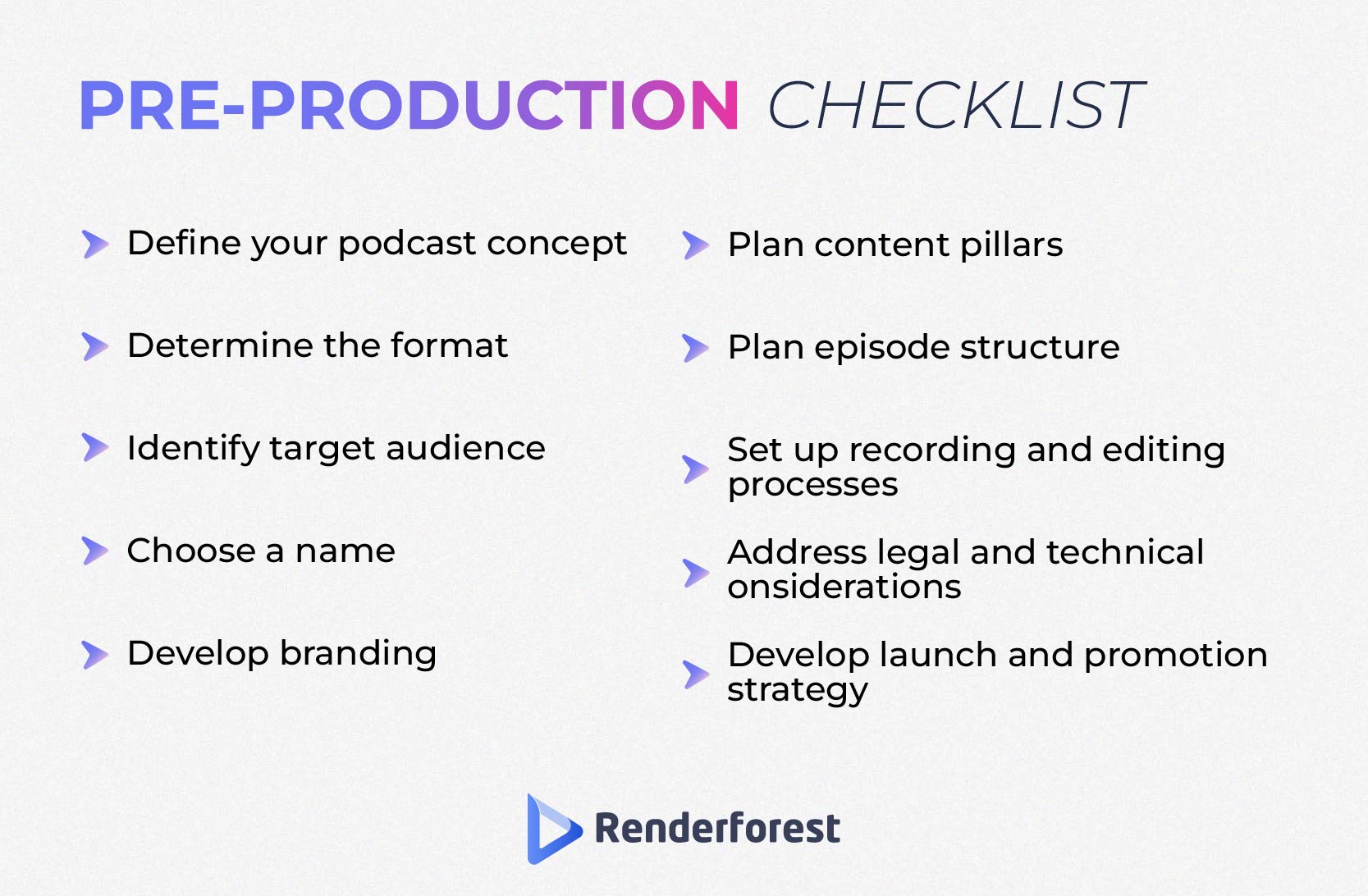
Setting up your podcast equipment is crucial for achieving high-quality audio.
Closed-back headphones are ideal for monitoring your recordings without picking up playback in your microphone. The Audio-Technica ATH-M50x is highly recommended.
An audio interface converts analog signals from your microphone to digital signals your computer can process. The Focusrite Scarlett 2i2 is a reliable option.
A pop filter reduces plosive sounds (like ‘p’ and ‘b’) that can cause distortion. It’s a simple, inexpensive addition to your setup.
This holds your microphone in place and helps reduce handling noise. Choose a sturdy option that can handle the weight of your microphone.
Acoustic treatment reduces echo and improves sound quality. Consider foam panels or portable vocal booths.
If you plan to record a video podcast, you’ll also need a good-quality camera, additional lighting, and a suitable backdrop. Learning how to start a podcast on YouTube involves more setup but can engage a wider audience on this popular platform. Video podcasts require additional equipment and planning, but the potential reach and engagement can be well worth the effort.
With the right equipment and setup, you’ll be sure your podcast sounds professional and engaging—be it audio-only or a video podcast.
Picking the right podcast platforms for recording and editing your podcast is key to producing high-quality episodes.

Audacity is a free, open-source audio editing software that’s popular among podcasters. It offers a wide range of features, including multi-track editing, noise reduction, and various effects.
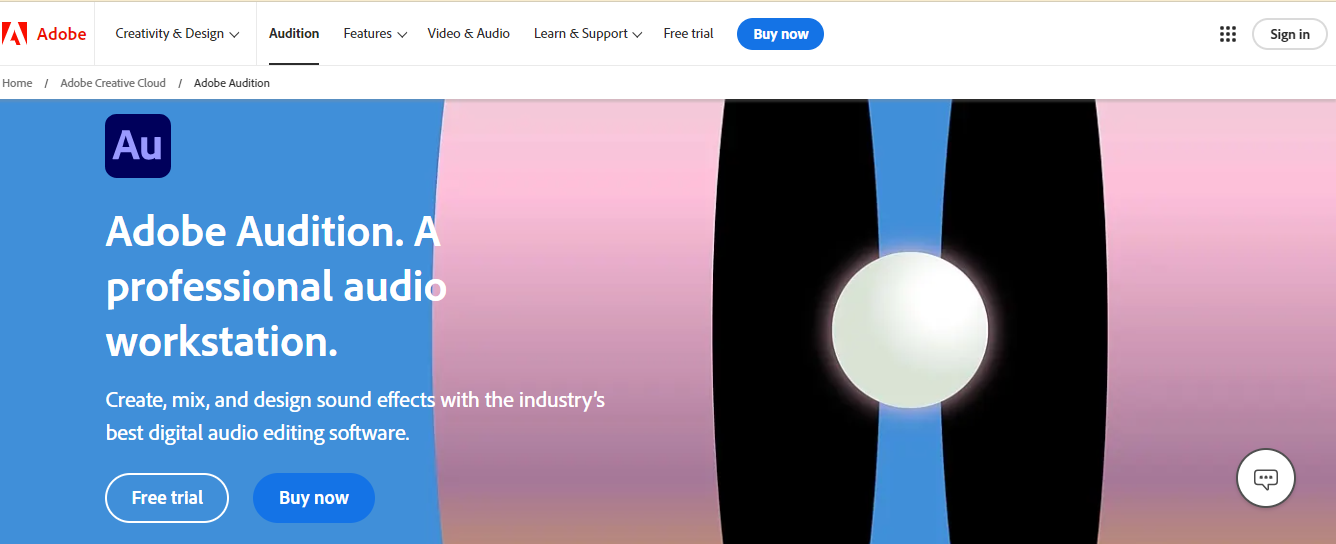
Adobe Audition is a professional-grade audio editing software program that’s part of the Adobe Creative Cloud suite. It’s packed with features like multi-track editing, powerful noise reduction tools, and advanced effects.
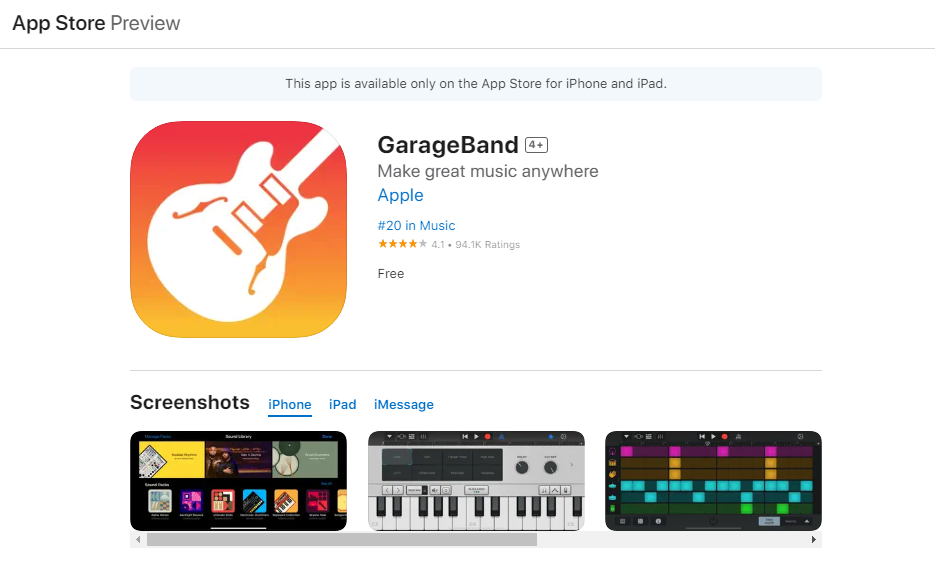
GarageBand is a digital audio workstation available on macOS and iOS. This free podcast software is great for beginners and offers multi-track recording, various sound effects, and easy integration with other Apple products.
Preparing your first podcast episodes involves careful planning and scripting to guarantee a smooth and engaging launch.
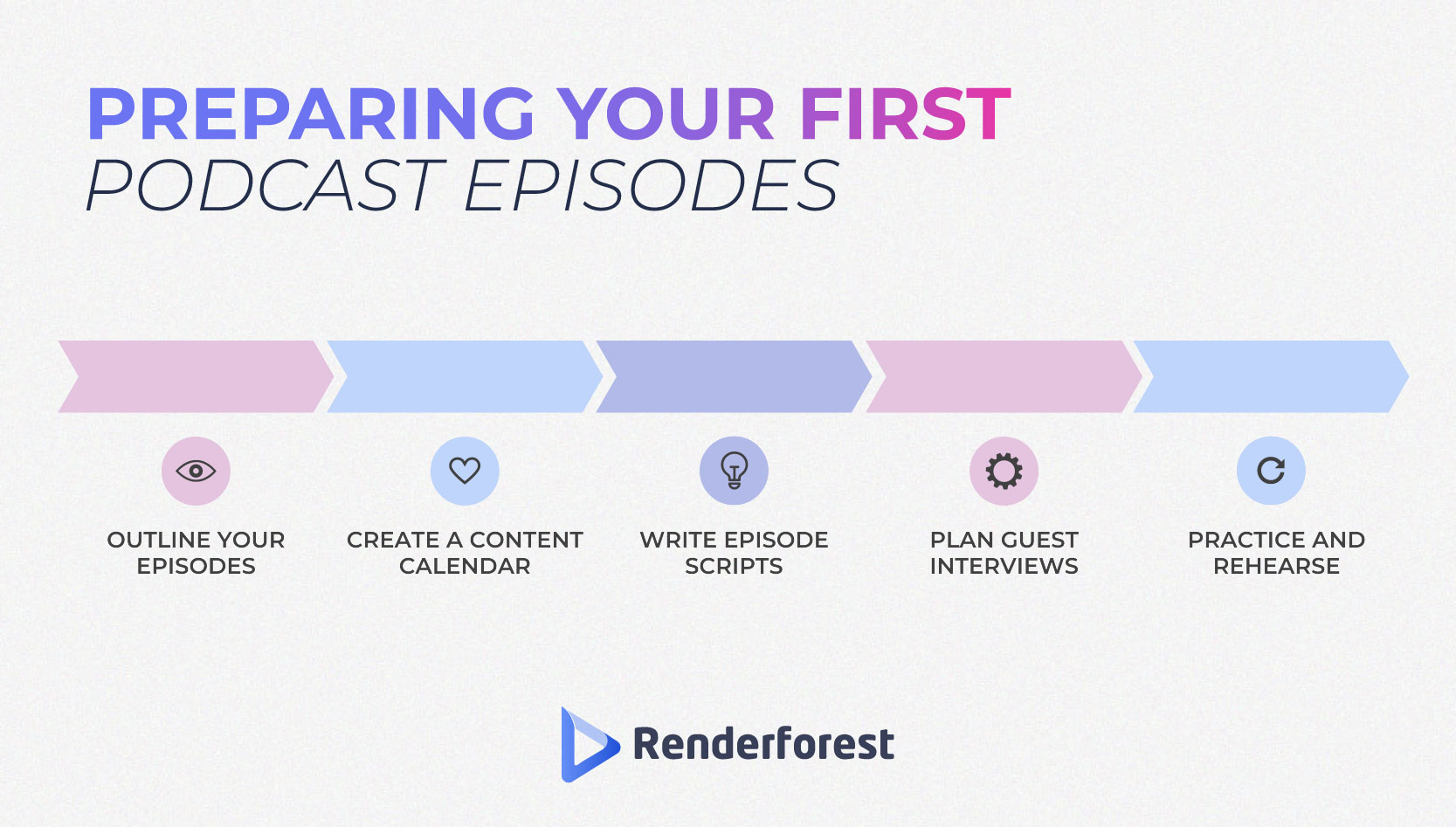
Recording high-quality audio is crucial for creating a professional podcast.
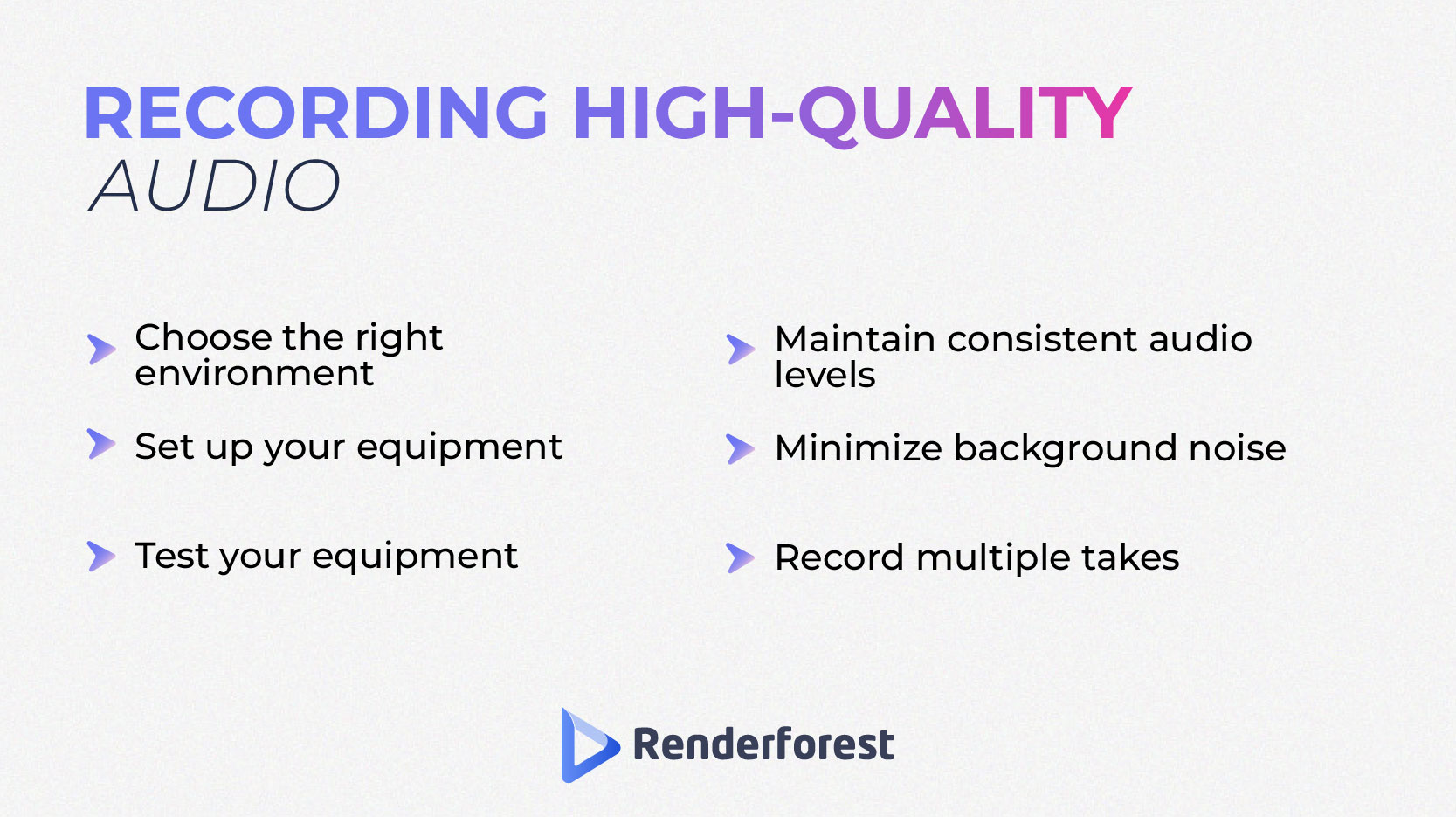
Editing and post-production are essential to making your podcast sound professional and polished.
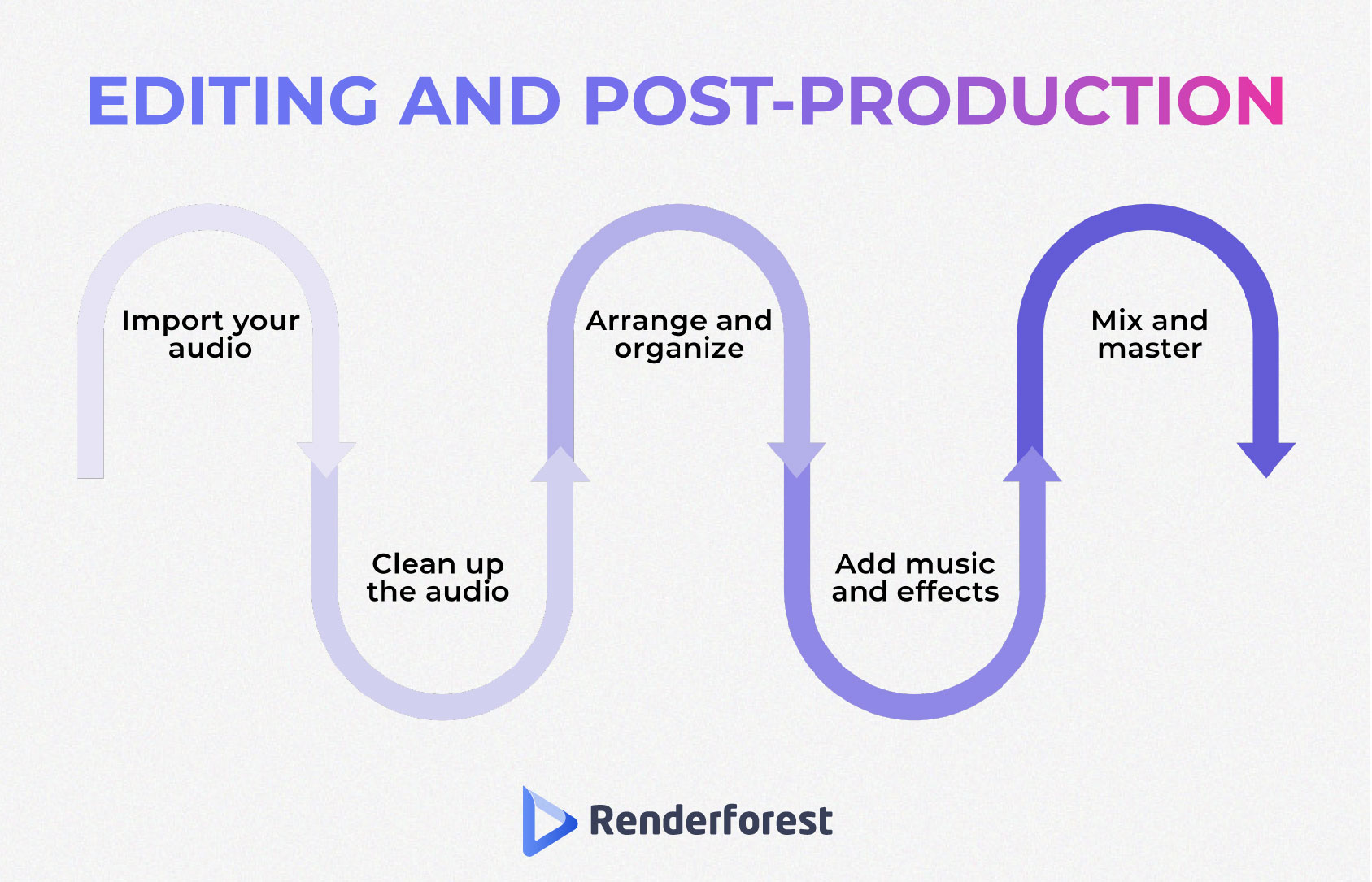
Load your recorded audio files into your editing software, such as Audacity, Adobe Audition, or GarageBand.
Eye-catching podcast artwork is essential to attract listeners.
Use clean, bold designs that are easy to read even when scaled down. Avoid clutter and too much text. Simple designs are more likely to catch the eye and be memorable.
Make sure your artwork conveys the essence of your podcast. Use relevant images or symbols that represent your content. This helps potential listeners understand what your podcast is about at a glance.
High-contrast colors help your cover art stand out in podcast directories. Ensure the text is readable against the background. Bright and contrasting colors make your cover pop.
Make your podcast’s name clearly visible and easy to read. Use large, legible fonts. This helps potential listeners immediately know what they’re looking at.
Use tools like Canva or Adobe Spark to create professional-looking cover art. These tools offer templates and design elements that make the process a breeze.
With nice cover art, your podcast will attract more listeners and make a strong first impression.
You’ve come a long way, and now it’s time for the most exciting step: publishing your podcast!
Platforms like Libsyn, Podbean, and Anchor host your podcast files and distribute them to directories. They make the process easy and offer great tools for podcasters.
Most hosting services generate an RSS feed for you. This feed is essential as it allows podcast directories to access your episodes.
Now that your podcast is out there, let’s talk about promoting and distributing it. This is where you can turn your hard work into a growing audience.
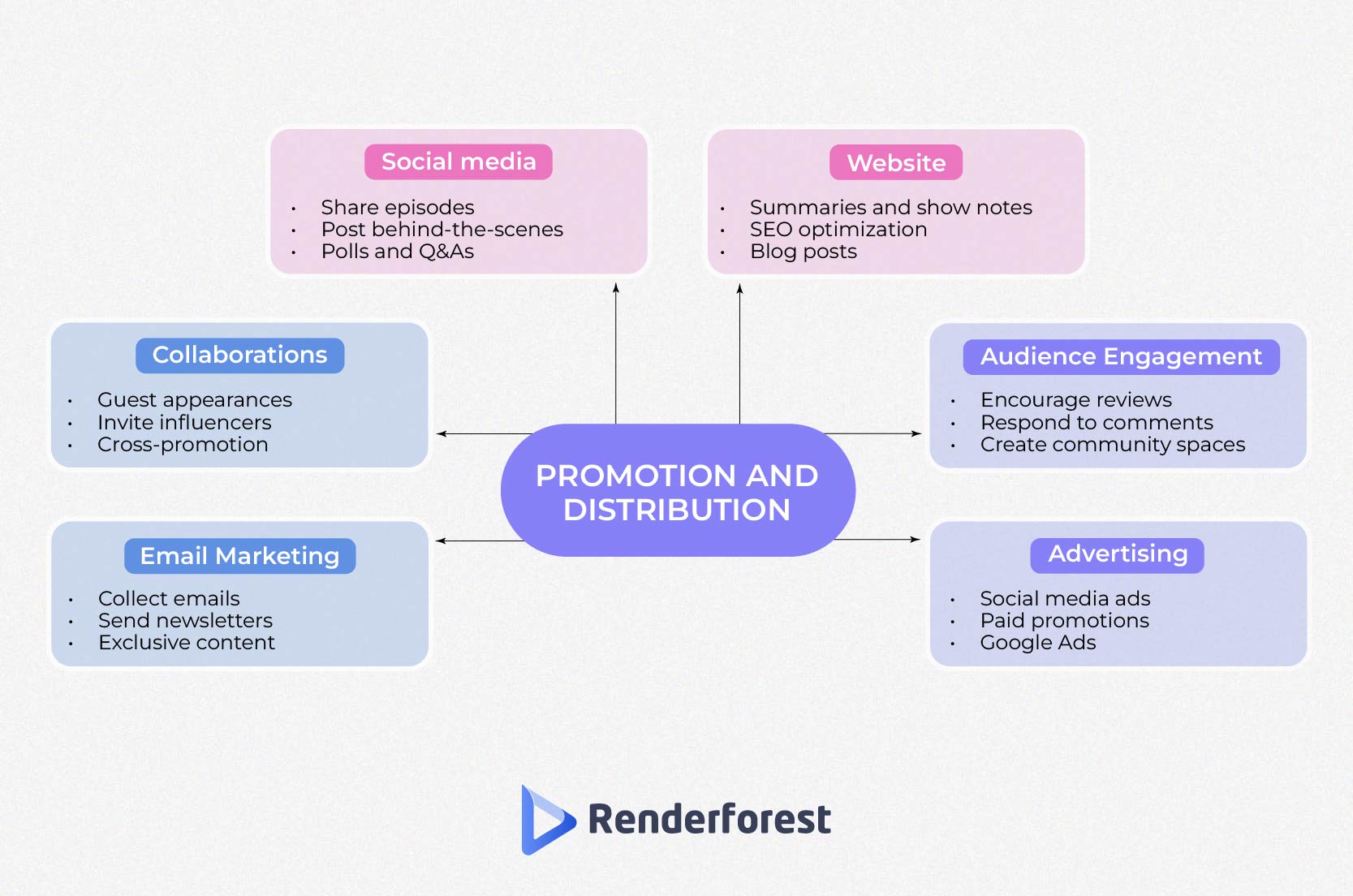
Now that you have your podcast, you’ll want to make it visually appealing. Renderforest’s audio podcast visualizer tool is perfect for this. While it’s not a podcast maker itself, it’s a great way to create visual components for your audio content. Here’s how you can turn your podcast into an engaging video using Renderforest:
First things first, you need to choose a template. Renderforest offers a variety of podcast visualizer templates. These templates are designed to add visual flair to your podcast episodes, making them more appealing to your audience.
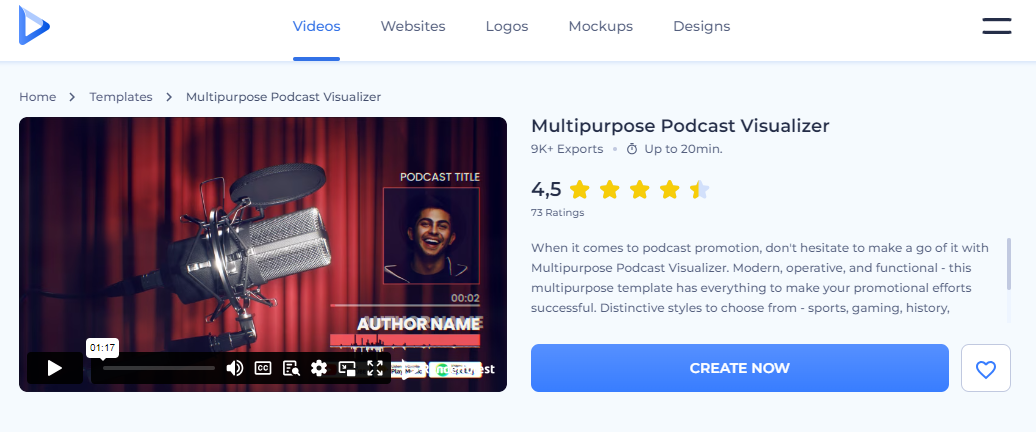
Take your time to explore the collection of podcast visualizer templates. Each one offers a unique style, so find one that resonates with your vision. For this guide, let’s use the multipurpose podcast visualizer template as an example. It’s versatile and great for various podcast themes.
Now comes the fun part—customizing your template. Renderforest’s video editor provides several options to tailor the template to fit your podcast’s brand and style.
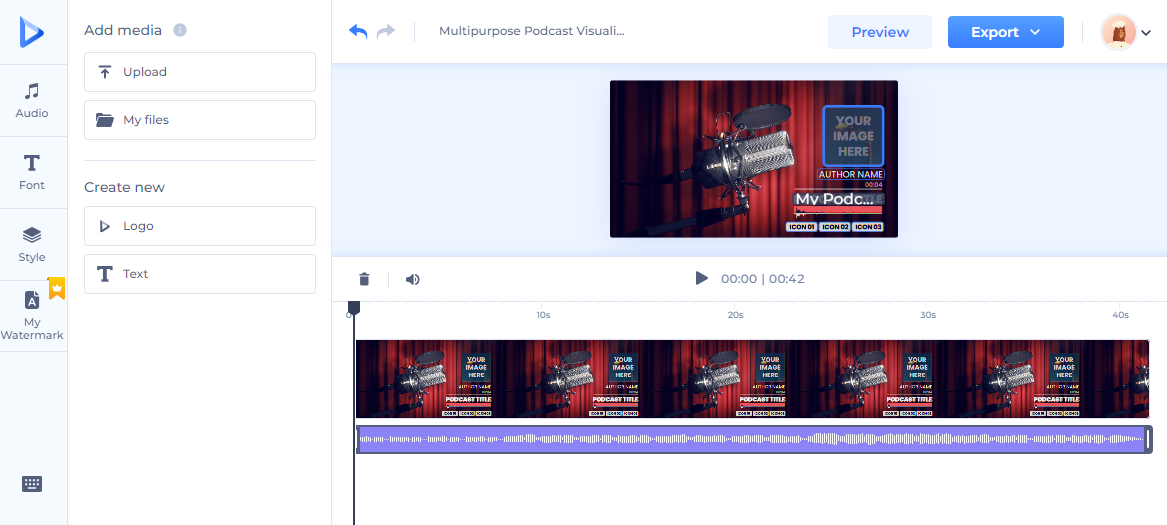
Click ‘Your image here’ and add your podcast logo. You can also add other relevant images or graphics that represent your podcast. Use high-resolution images so your logo looks sharp and professional. If you don’t have a logo yet, simply click the “Logo” button in the “Create new” section on the left and use our logo generator to come up with one right away.
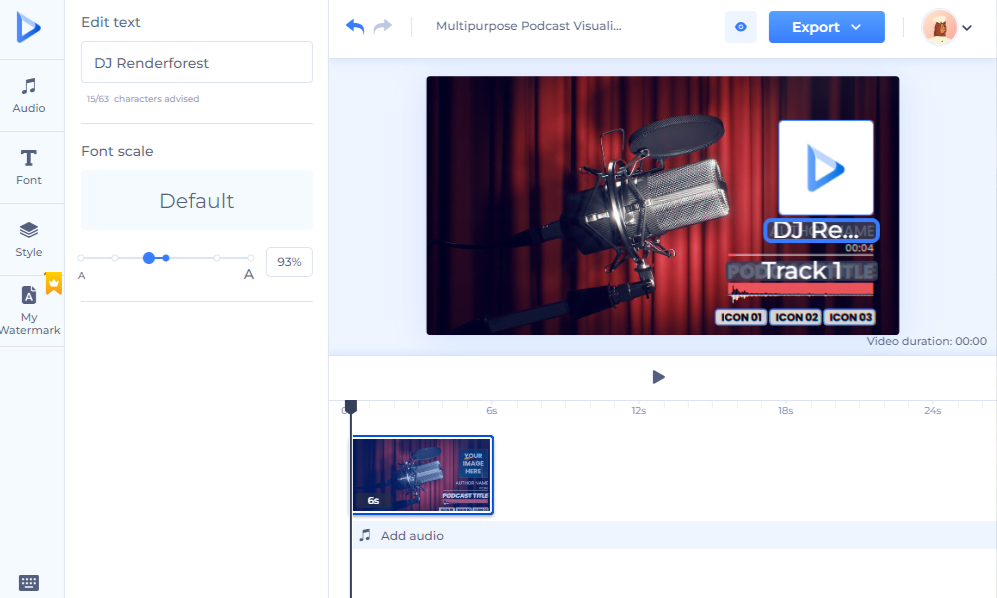
Enter your podcast’s name, episode title, and any additional information you want to display. Use clear, legible fonts that match your podcast’s style. Play around with different fonts, sizes, and colors until you find a combination that looks great and matches your branding.
Click on the color palette to change the colors of various elements in your template. Stick to a color scheme that matches your podcast’s overall look and feel. Use contrasting colors to make text and important elements stand out. Avoid using too many different colors to keep the design cohesive.
Click the ‘Upload’ button and select your podcast’s audio file. The audio visualizer will automatically sync to the audio, creating engaging visual effects that move with the sound. Make sure your audio file is high quality. Clear and crisp audio will make your visualizer more enjoyable for both listeners and viewers.
Click on the watermark option and upload your podcast’s logo. This adds an extra layer of branding and helps protect your content. Place the watermark in a corner where it’s visible but not intrusive. Adjust the opacity if needed.
Before finalizing, preview your video to see how all the elements come together. This step is crucial to catch any errors or adjustments you might want to make. Play the video and check:
Once you’re happy with your video, it’s time to share it with the world.

Starting a podcast is an exciting adventure. Whether you’re a hobbyist or looking to grow your brand, understanding the costs involved can help you plan effectively and avoid surprises. If you’re wondering how to start a podcast for free, there are several strategies and tools available that can help you minimize expenses while still producing high-quality content. Let’s break down the typical expenses so you can budget your podcasting journey wisely.
The microphone is your most crucial piece of equipment. You can start with a decent USB microphone for around $50, which is easy to use and offers good quality. As you become more serious about podcasting, you can upgrade to a professional XLR microphone, which can cost up to $300. These higher-end mics often provide superior sound quality and durability, but you’ll need an audio interface to connect them to your computer.
Quality headphones are essential for monitoring your recordings. In the $50 to $150 range, you’ll find headphones that offer clear sound and comfort for long editing sessions. Over-ear headphones are generally preferred as they block out external noise and provide a better listening experience.
A pop filter is a simple yet vital accessory. It attaches to your microphone stand and helps reduce plosive sounds that can distort your sound. It’s a small investment that makes a big difference in audio quality.
These stands hold your microphone in place, keeping it stable and at the right height. A boom arm, which attaches to your desk, can be adjusted easily and keeps your workspace organized. Mic stands are more portable and can be a cheaper option.
If you opt for an XLR microphone, you’ll need an audio interface to connect it to your computer. This device converts the analog signal from the microphone into a digital signal your computer can process. The Focusrite Scarlett 2i2 is a popular choice with excellent quality and reliability.
Audacity is open-source and works on both Windows and Mac. It’s great for beginners with its straightforward interface. GarageBand, available for Mac users, is also free and comes with a variety of features and loops that are perfect for creating professional-sounding podcasts.
Adobe Audition is a powerful tool for those willing to invest in professional-grade software. It offers advanced editing features, seamless integration with other Adobe products, and excellent customer support.
Anchor is a great free option for beginners. It’s easy to use and provides all the basic features you need to start your podcast, including distribution to major platforms and basic analytics.
These platforms offer more advanced features, such as detailed analytics, monetization options, and greater storage capacity. They are popular choices for podcasters who want to grow their audience and professionalize their podcasting efforts.
Having your own domain makes your podcast look professional and helps with branding. It’s an essential investment for serious podcasters.
Platforms like Bluehost or SiteGround offer affordable hosting options. Having a website allows you to centralize all your content, provide additional resources like show notes and transcripts, and connect with your audience through blogs or forums.
Canva is user-friendly and perfect for creating logos and cover art. Even the free version offers plenty of templates and design elements.
Hiring a professional designer can give your podcast a unique and polished look. This can be especially important for standing out in a crowded market.
Running ads on social media platforms like Facebook and Instagram can help you reach a larger audience. Target your ads to the demographics most likely to be interested in your podcast.
Use email marketing to keep your audience engaged and informed about new podcast episodes, special content, and updates. Building an email list is a great way to maintain direct communication with your listeners.
Starting a podcast is not only a great way to share your passion but also an excellent opportunity to make money. Let’s explore some monetization strategies to help you turn your podcast into a profitable venture. Here is how you can get started:
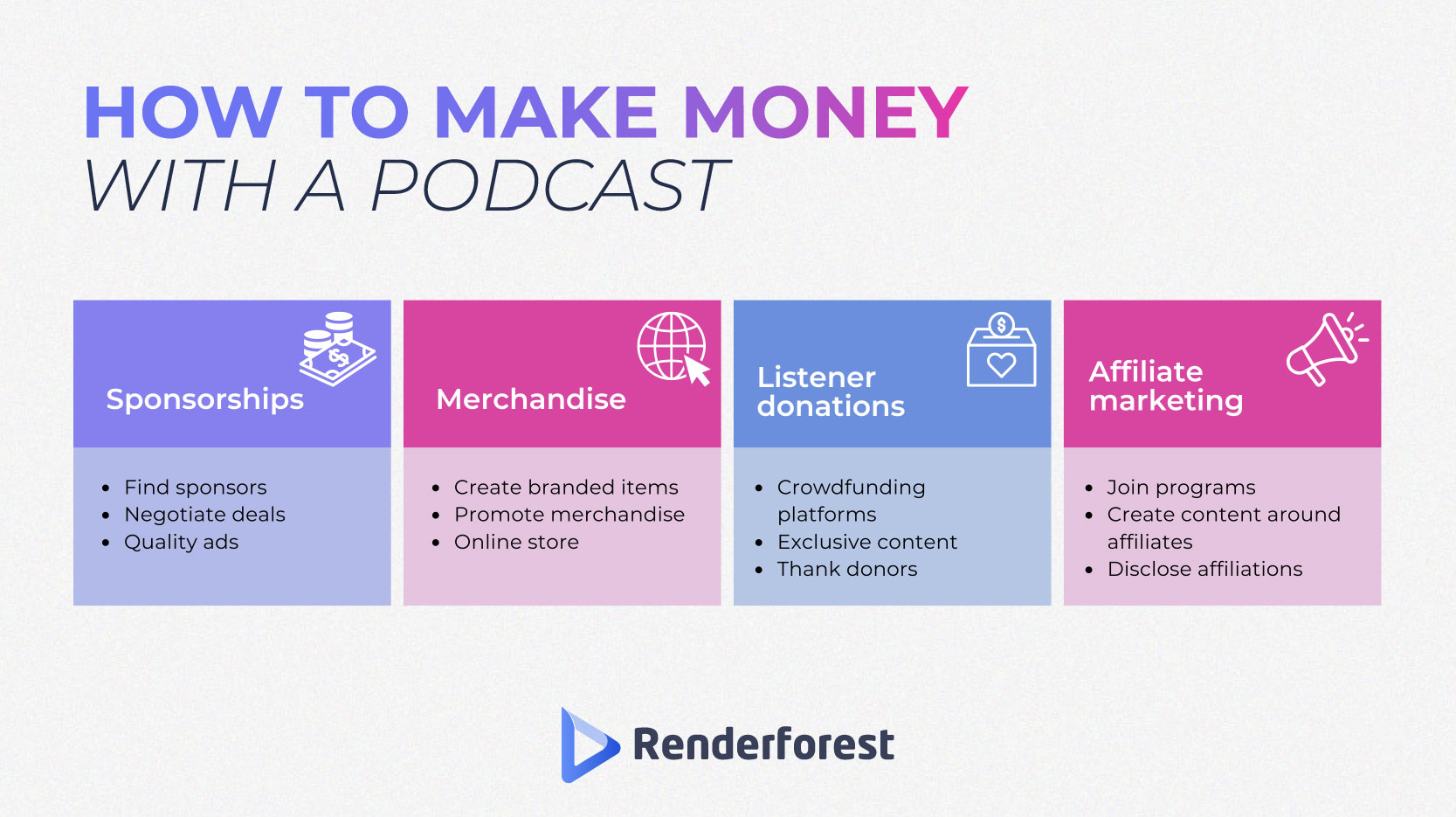
Starting a podcast is an exciting and rewarding journey that offers numerous opportunities to share your passion and potentially earn money. Whether you’re starting with a budget or no money at all, the key is to take the first step and enjoy the process of creating and growing your podcast.
With the right equipment, recording software, and a reliable hosting platform, you’re set to distribute your episodes. You can explore monetization strategies like sponsorships, ads, merchandise, listener donations, and affiliate marketing. Most importantly, focus on creating engaging content and building a strong connection with your audience. Now that you have this guide at hand, it’s time to get started—grab your microphone, hit record, and dive into this rewarding and unforgettable journey.
Related reading:
Podcast production can range in cost. Basic equipment such as a microphone, headphones, and a pop filter can cost around $200 to $300 altogether. If you opt for more professional gear, it might cost $500-$800. Recording software can be free or up to $20 a month, and hosting services range from free to $15 a month. Ultimately, you can start a podcast with a budget as low as $200 or up to $1,000 for more advanced setups.
Starting a podcast involves several key steps. Begin by planning your content by choosing a niche and defining your target audience. Then, invest in essential equipment like a good microphone and headphones. Next, use recording software to record and edit your episodes. Once your content is ready, choose a hosting platform to distribute your podcast to various directories. Finally, publish your episodes and promote your podcast to attract listeners.
Yes, podcasts can generate income. Several monetization strategies are available for podcasters. Sponsorships involve partnering with companies that align with your podcast’s theme. Advertisements can be placed at different points in your episodes. Selling merchandise such as branded T-shirts or mugs can also generate revenue.
On top of that, listener donations through platforms like Patreon or Buy Me a Coffee provide direct financial support. You also have affiliate marketing, where you can earn a commission by promoting products or services relevant to your audience. These methods can help podcasters earn money while creating engaging content.
It is possible to start a podcast with no initial investment. Using equipment you already have, such as a smartphone and free software like Audacity or GarageBand, you can record and edit your episodes without spending any money. Free hosting platforms like Anchor allow you to distribute your podcast without costs. While starting with zero expenses is possible, investing in better equipment and services as your podcast grows can improve its quality and reach. This approach allows you to start podcasting even on a tight budget.
Article by: Sara Abrams
Sara is a writer and content manager from Portland, Oregon. With over a decade of experience in writing and editing, she gets excited about exploring new tech and loves breaking down tricky topics to help brands connect with people. If she’s not writing content, poetry, or creative nonfiction, you can probably find her playing with her dogs.
Read all posts by Sara Abrams
